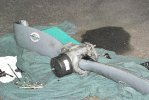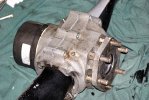 Interesting units these… all the more so when ya get to pull them apart, and yes the grease was handy 🙂 This one is a recent MLG failure victim (Chieftian if I remember correctly), quite a nice Hartzell in its working days…
Interesting units these… all the more so when ya get to pull them apart, and yes the grease was handy 🙂 This one is a recent MLG failure victim (Chieftian if I remember correctly), quite a nice Hartzell in its working days…
Propeller construction may consist of an aluminum “clam-shell” hub where the hub captures the blades, or a steel hub “spider” design where the blades are clamped to a hub . The blades may be made from an aluminum forging or from either Kevlar 49® or Carbon based fabrics or unidirectional tapes. The composite blades would additionally incorporate a leading edge erosion sheath to protect the blade from both abrasion (sand) and erosion (water) as well as offer an external conductive for a lightning strike.
The pitch control typically comes from a hydraulic fly-ball governor mounted on the engine. The governor senses whether the engine/propeller is running at the correct RPM and either supplies or maintains oil flow to the propeller, or drains oil to the engine sump. Of course, it is very important that the engine-mounted governor be properly matched to the propeller for proper pitch change command and response. The governor may or may not be supplied by the propeller manufacturer; however, it is necessary to ensure the propeller manufacturer has approved the governor for use with its propeller. In addition to controlling the propeller, this governor typically contains a pump that increases the oil pressure to a higher level than that which the engine supplies to a value sufficient to control the propeller.
On turbine-powered aircraft, it is normal to include an overspeed governor into the propeller control system that backs-up the primary propeller governor. Therefore, if the primary governor fails in such a manner as to command a reduced pitch (increased RPM), it can be overridden by the overspeed governor whose setting is just above normal maximum RPM, and therefore the overspeed governor can provide sufficient RPM control to so as to allow the aircraft to safely land. An overspeed governor is not used on reciprocating engines because the reciprocating engine can be sufficiently slowed (in such a failure mode condition) with a throttle reduction so as not to overspeed. The overspeed governor is often not supplied by the propeller manufacturer.
On twin-engine aircraft, whether they are reciprocating or turbine-powered, the propeller governor or synchronizer may be supplemented with an electronic synchrophaser. One purpose of the synchrophaser is to match the two propellers to the same RPM. However, the more difficult and relevant task of the synchrophaser is to match not only the RPM, but also the phase position between the two propellers. In other words, when a blade on one propeller passes the fuselage, a blade on the other propeller is operating at the same speed and is at a specific and predefined relative position. In doing so, airframe vibration and cabin noise can be substantially reduced.









